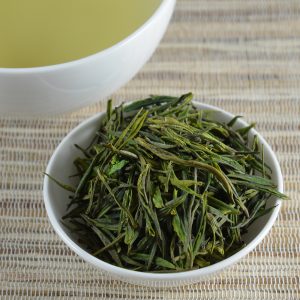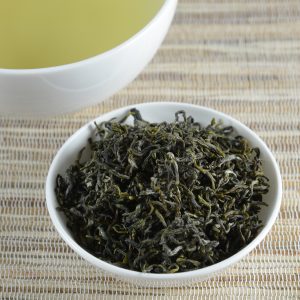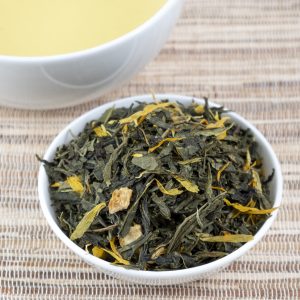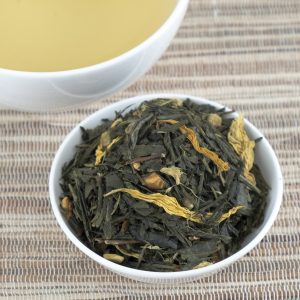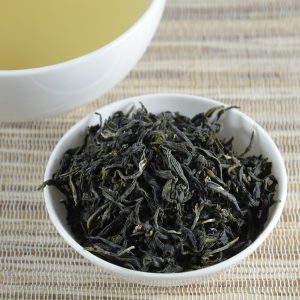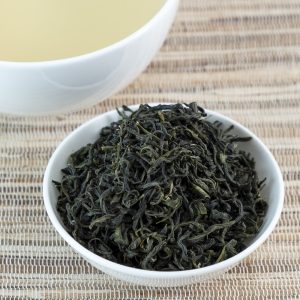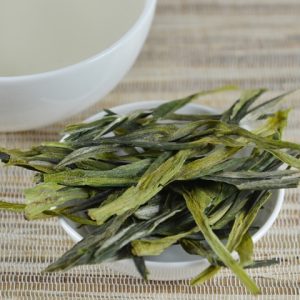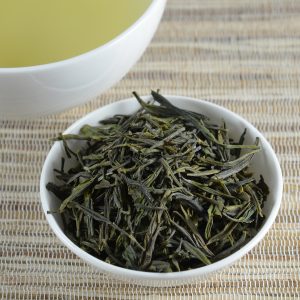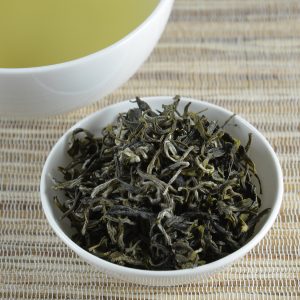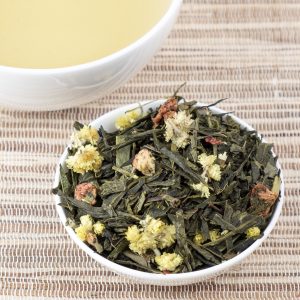Green tea
Green tea – discover its diversity
Harvesting and production
Green tea is obtained from the same plant as black tea, from the leaves of the tea plant Camellia Sinensis, which originates in the highlands of southern China.
For green tea, mainly the young shoots are harvested with their valuable ingredients as well as the characteristic flowery-fresh aroma. As with black tea, “two leaves and a bud” are usually harvested. The tea leaves are heated immediately after harvesting to prevent oxidation. This preserves the valuable ingredients and the fresh taste. In China this is traditionally done in a pan and in Japan by steaming with hot water vapor. Carefully, the leaves are now rolled or flattened in various ways, depending on the variety, to cause small cell injuries. The cell juice can escape and intensifies the taste of the green tea.
Preparation
Our green teas can and should be brewed several times, up to four times, to enjoy the full range of flavors.
To allow the leaves to unfold well in the cup, it is best to use a tea strainer.
You will find on our labels the infusion temperature and the infusion time of each type of green tea, which varies from 65° to 80°C and 1 to 3 minutes. If you do not have a kettle where you can regulate the temperature, let the boiling water cool for about 5 minutes.
If you let green tea steep longer than 3 minutes, the tannins in the water will dissolve, making the green tea taste bitter. These tannins are not harmful or unhealthy, they only affect the enjoyment. They also have a soothing effect on the stomach and intestines and bind the caffeine, which is thus absorbed more slowly by the body.
Tip: In the hot season, green tea also tastes good cold. There are two ways to prepare it:
For the typical cold brew, we recommend the exclusive, Japanese green teas. Pour the green tea cold and let it steep for 8 to 12 hours in the refrigerator. With this preparation method, you get a strong green tea with all its flavor nuances, including the tannins and bitter substances.
The second option is to prepare a brew with half the water than usual and pour it over ice cubes immediately after brewing. This method of preparation produces a smoother infusion.
Depending on your preference, you can sweeten the cold tea with some syrup.
Storage
You will receive our tea in special flavor sealing bags. Since green tea loses its aroma and quality more quickly than other teas, it should be stored in an airtight, cool, dry and dark place.
Growing areas
70% of the tea production in China is green tea. The well-known tea growing areas include Lung Ching, Anhui, Yunnan and Fujian. The top tea growing areas in Japan are Shizuoka, Kagoshima and Uji. Meanwhile, excellent green teas from Korea, Taiwan and Sri Lanka are also available.
Diverse green tea varieties
When it comes to green tea, one encounters a large selection, as there are now more than 1500 different varieties. Here we would like to present a small selection of excellent green teas:
Gunpowder
This green tea originating from China is roasted and rolled into small balls, which gave the tea the name Gunpowder.
Jasmine tea
Freshly picked jasmine flowers are added to the Chinese Chung Feng and sorted out again by hand after the green tea has taken on the scent of the flowers. This process is repeated up to four times for optimal aroma.
Shincha
Sencha
Sencha is the everyday tea of the Japanese and grows unshaded in direct sunlight until it is harvested. Unlike Shincha, Sencha is harvested from the top five leaves. Its taste is intense, fresh with tangy-grassy notes and fruity-sweet nuances. The earlier harvested, the sweeter and more mellow. Its distinctive, unique flavor is best described as “umami,” which translates as “savory”
Bancha
Bancha comes from Japanese and means “ordinary tea.” The second most commonly drunk tea in Japan, with its calm, relaxing character, it is mild and wholesome. It contains little caffeine. The pluckings are from the late spring and early summer harvests.
Matcha
Matcha is Japanese and means “ground tea”. This particularly fine type of tea is intensely green because it is usually shaded for four weeks before harvesting. This increases the chlorophyll content and aroma in the leaves. Earlier pluckings are sweet in flavour, while later harvests are slightly tart. After harvesting, the leaves are steamed, dried and ground into fine powder in stone mills. This matcha powder is very productive and less than a level teaspoon of powder is enough for a glass or bowl, depending on preference. Pour hot water (60-80°C) over the powder and mix it with a matcha whisk. Tip: Enjoy it as a matcha latte with oat milk and a few drops of vanilla flavoring.
Kukicha
The Japanese words Kuki (meaning “stem”) and Cha (meaning “tea”) indicate that this is a green tea made primarily from the leaf veins and twigs. Its taste is tart-sweet and medium-bodied. It contains less caffeine than other types of green tea and is rich in minerals and vitamins.
Genmaicha
Japanese Sencha to which roasted brown rice (jap. “Genmai”) has been added. According to legend, this combination was born in the 15th century from the carelessness of a servant who had roasted the tea along with the rice. The servant had to pay with his life, but this new tea remained. Originally a stretched poor man’s tea, it is now enjoyed by all classes of the population. Its spicy, slightly malty roasted aroma fits wonderfully into Far Eastern cuisine.
Gyokuro
Next to Matcha, Gyokuro is the highest quality Japanese green tea. Three weeks before harvesting the plant covered with tightly woven nets, bamboo, reed or rice straw mats, so that 90% of the sunlight is filtered out. Only the tender, young and soft tea leaves are picked, which contain a higher chlorophyll and caffeine content and fewer tannins and bitter substances due to the shading. The taste is accordingly mild, slightly sweet and highly aromatic (umami). Prepare this exclusive green tea with only 50-60°C warm water and let it steep for 2 minutes. Due to its high caffeine content, this green tea is stimulating.
Flavored green teas
In addition to the pure green teas, we also carry various flavored green teas, e.g. with cherry blossoms, ginger and lemongrass, vanilla or with bergamot oil (Earl Grey).
Caffeine content in green tea
Teein and caffeine are chemically the same thing. However, the effect is different because the caffeine in tea is bound to tannins, which slows its absorption in the body. Therefore, green tea is not immediately stimulating like coffee, but it is longer lasting. The longer you steep the tea, the more tannins are washed out and the more caffeine is released.
The caffeine content per cup of green tea is between 20 and 45 mg (comparison: coffee has 50-100 mg, black tea 25-110 mg caffeine). It should be noted that the caffeine content varies depending on the amount of tea leaves/coffee, brewing time, variety and water temperature.
Effect
About the effect of green tea there are quite a few articles and research results. Here is a small excerpt:
– It strengthens our immune system and has a beneficial effect on the heart and circulation.
– It has a caries-inhibiting effect.
– It serves for the dehydration and is thus body-detoxifying.
– It increases mental and physical performance.
– It contains zinc, magnesium, important trace elements and vitamins (A, B1, B2, B12, E, P, a lot of C).
